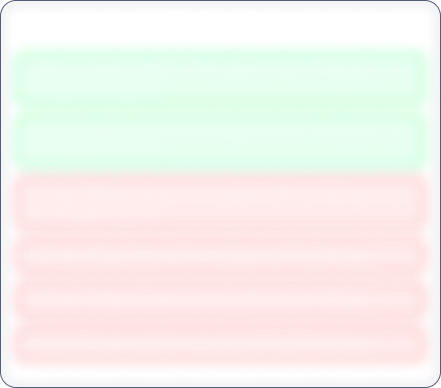Year End Sale 50% off
Gokul Agro Resources

No Data Available
Investor Sentiment
Gokul Agro Resources Share price and Fundamental Analysis
Key Metrics
Included In
Stock Returns
Stock Heatmap

No Stocks
Smart Score

Unlock Smart Score
See Detailed Analysis & Insights


Unlock Insights
See Detailed Analysis & Insights
Technicals
Returns Calculator
If you would have investedResearch Report
No Research Report
Corporate Action
Financials
Key Ratios
ROE
Avg ROE (3 Yrs) : NaN%
ROCE
Avg ROCE (3 Yrs) : NaN%
ROA
Avg ROA (3 Yrs) : NaN%
NPM
Avg NPM (3 Yrs) : NaN%
Dividend History
5 Year FactSheet
Documents

No Data Available
News
Gokul Agro Resources Management and History
Company Management


Unlock Management Data
See Detailed Analysis & Insights
Company History
Gokul Agro Resources Limited (GARL) de-merged entity of GOKUL REFOILS & SOLVENT LTD, Gandhidham unit, is one of the leading FMCG Companies of India with international presence having state of the art manufacturing and processing facilities for various kinds of Edible and Non-Edible oils and meals. It is an ISO 22000:2005 certified company with its customers spread across the world.
GARL operates across the world with its trade and also have a subsidiary in Singapore in order to cater its international trading operations in the key parts of the world. GARL has its extensive marketing and distribution network which reaches out the customers of 20 states in India. We cater these sates with products such as Soya bean oil, Cottonseed oil, Palm oil (Palmolein), Sunflower oil, Groundnut oil, Vanaspati etc.
GARL has been engaged in manufacturing and exports of industrial products viz. castor oil of various grades and its derivatives. It also has one of the largest manufacturing facilities to produce various grades of castor oil and also Castor de-oiled cakes etc. GARL'S manufacturing facilities have been approved by many international importers / end users and which is why GARL established a huge loyal customer base in various countries across continents. The company supplies its products to United States, South Korea, European Union, China, Singapore, Indonesia, Malaysia, Russia and Vietnam.
The Company owns state of the Art production facility equipped with latest equipment and technology in Gandhidham, Gujarat, India. GARL proximity to ports and connectivity with major rail/road networks not only ensures uninterrupted supply of raw materials with cost effectiveness but also facilitates extensive distribution of our production domestic and international markets at optimal supply chain cost.
Gokul Agro Resources Share Price
Gokul Agro Resources share price reflects investor sentiment toward the company and is impacted by various factors such as financial performance, market trends, and economic conditions. Share price is an indicator which shows the current value of the company's shares at which buyers or sellers can transact.
Gokul Agro Resources Market Cap
Market capitalization of Gokul Agro Resources indicates the total value of its outstanding shares. Marketcap is calculated by multiplying share price and outstanding shares of the company. It is a helpful metric for assessing the company's size and market Valuation. It also helps investors understand how Gokul Agro Resources is valued compared to its competitors.
Gokul Agro Resources PE Ratio
Gokul Agro Resources PE ratio helps investors understand what is the market value of each stock compared to Gokul Agro Resources 's earnings. A PE ratio higher than the average industry PE could indicate an overvaluation of the stock, whereas a lower PE compared to the average industry PE could indicate an undervaluation.
Gokul Agro Resources PEG Ratio
The PEG ratio of Gokul Agro Resources evaluates its PE ratio in relation to its growth rate. A PEG ratio of 1 indicates a fair value, a PEG ratio of less than 1 indicates undervaluation, and a PEG ratio of more than 1 indicates overvaluation.
Gokul Agro Resources ROE (Return on Equity)
Return on Equity (ROE) measures how effectively Gokul Agro Resources generates profit from shareholders' equity. A higher ROE of more than 20% indicates better financial performance in terms of profitability.
Gokul Agro Resources ROCE (Return on Capital Employed)
Return on Capital Employed (ROCE) evaluates the profitability of Gokul Agro Resources in relation to its capital employed. In simple terms, ROCE provides insight to investors as to how well the company is utilizing the capital deployed. A high ROCE of more than 20% shows that the business is making profitable use of its capital.
Gokul Agro Resources Total Debt
Total debt of Gokul Agro Resources shows how much the company owes to either banks or individual creditors. In simple terms, this is the amount the company has to repay. Total debt can be a very useful metric to show the financial health of the company. Total debt more than equity is considered to be a bad sign.
Gokul Agro Resources Debt to Equity Ratio
The Debt-to-Equity (DE) ratio of Gokul Agro Resources compares its total debt to shareholders' equity. A higher Debt to Equity ratio could indicate higher financial risk, while a lower ratio suggests that the company is managing its debt efficiently.
Gokul Agro Resources CAGR (Compound Annual Growth Rate)
CAGR shows the consistent growth rate of Gokul Agro Resources over a specific period, whether it is over a month, a year, or 10 years. It is a key metric to evaluate the company’s long-term growth potential. Main metrics for which CAGR is calculated are net sales, net profit, operating profit, and stock returns.
Gokul Agro Resources Technical Analysis
Technical analysis of Gokul Agro Resources helps investors get an insight into when they can enter or exit the stock. Key components of Gokul Agro Resources Technical Analysis include:
Support Levels (S1, S2, S3)
There are usually multiple support levels, but the main support levels for a stock are S1, S2, S3. Support levels indicate price points where stock might get support from buyers, helping the stock stop falling and rise.
Resistance Levels (R1, R2, R3)
There are usually multiple resistance levels, but the main resistance levels for a stock are R1, R2, R3. Resistance levels represent price points where Gokul Agro Resources shares often struggle to rise above due to selling pressure.
Gokul Agro Resources Dividends
Dividends refer to the portion of the company’s profits distributed to its shareholders. Dividends are typically paid out in cash and reflect Gokul Agro Resources ’s financial health and profitability.
Gokul Agro Resources Bonus Shares
Bonus shares are usually given by companies to make the stock more affordable, increase liquidity, boost investor confidence, and more.
Gokul Agro Resources Stock Split
Stock split increases the number of its outstanding shares by dividing each existing share into multiple shares. When the company offers a stock split, the face value of the stock reduces in the same proportion as the split ratio.
Gokul Agro Resources Financials
The financials of Gokul Agro Resources provide a complete view to investors about its net sales, net profit, operating profits, expenses, and overall financial health. Investors can analyze financial data to assess the company’s stability and also understand how the company has been growing financially.
Gokul Agro Resources Profit and Loss Statements
The profit and loss statement of Gokul Agro Resources highlights its net sales, net profit, total expenditure, and operating profits in the current financial year. This Profit and Loss statement is crucial for evaluating the profitability and financial stability of Gokul Agro Resources .
Gokul Agro Resources Balance Sheet
The balance sheet presents a snapshot of Gokul Agro Resources ’s assets, liabilities, and equity of shareholders, providing insights into the financials of the company.
Gokul Agro Resources Cashflow Statements
Cashflow statements track the company's cash inflows and outflows over a period. It is an essential tool for understanding how well the company manages its liquidity and finances.


